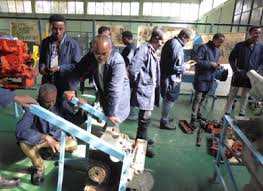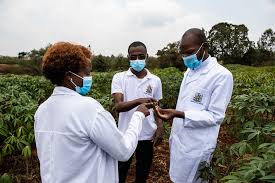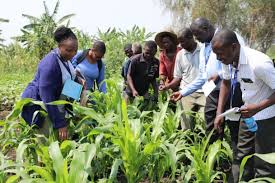Agriculture has long been the backbone of economies worldwide, serving as a fundamental driver of growth and development. Its significance extends beyond mere food production, influencing various sectors and fostering economic stability. In many developing nations, agriculture remains the primary source of employment, providing livelihoods for a significant portion of the population.
This dependence on agriculture is crucial, as it not only ensures food security but also stimulates rural development, reduces poverty, and enhances overall economic resilience.
Agricultural practices contribute to economic development through multiple channels. First, they generate income for farmers and workers, which circulates within local economies, boosting demand for goods and services.
This increased economic activity often leads to improvements in infrastructure, such as roads and market facilities, further enhancing agricultural productivity.
Moreover, agriculture acts as a catalyst for industrial growth by providing raw materials for food processing, textiles, and biofuels, creating a symbiotic relationship between the agricultural and industrial sectors.
Furthermore, agriculture plays a critical role in international trade. Countries rich in agricultural resources can export their products, generating foreign exchange and enhancing their balance of trade. This trade not only brings in revenue but also fosters global partnerships and economic integration.
Additionally, advancements in agricultural technology and practices have led to increased efficiency and sustainability, ensuring that the sector can meet the demands of a growing global population.
Agriculture is not just a sector; it is a vital pillar of economic development. Its ability to drive income, employment, and trade makes it indispensable for sustainable growth, particularly in developing regions.
Recognizing and investing in agriculture is essential for fostering economic resilience and achieving long-term development goals.
Historical Overview of Agriculture’s Economic Impact

Agriculture has profoundly shaped human civilization and its economic development throughout history. The transition from nomadic hunter-gatherer societies to settled agricultural communities marked a significant turning point in human existence.
This shift, often referred to as the Agricultural Revolution, allowed for food surplus, leading to population growth, the establishment of towns, and the development of trade systems.
1. The Agricultural Revolution (10,000 BCE – 3,000 BCE): The earliest forms of agriculture began around 10,000 BCE, when humans started to domesticate plants and animals. This transition enabled societies to cultivate crops and raise livestock, which provided a stable food source.
As a result, communities grew, and social structures emerged, fostering the development of trade. Surpluses allowed for specialization of labor, leading to advancements in various crafts and industries.
2. Ancient Civilizations (3,000 BCE – 500 CE): In ancient civilizations like Mesopotamia, Egypt, and the Indus Valley, agriculture became central to economic stability. Irrigation systems improved crop yields, supporting larger populations.
The surplus produced not only fed the populace but also contributed to the rise of trade networks, enabling societies to exchange goods and ideas. This era laid the foundation for economic systems based on agricultural output.
3. The Middle Ages (500 CE – 1500 CE): During the Middle Ages, feudalism dominated Europe, with agriculture as the primary economic activity. Land ownership determined wealth and power, leading to the establishment of manorial systems.
Peasants worked the land in exchange for protection and a portion of the produce. Agricultural advancements, such as crop rotation and improved plowing techniques, increased productivity and contributed to population growth.
4. The Agricultural Revolution (17th – 19th Century): The Agricultural Revolution of the 17th and 18th centuries introduced significant innovations, including crop rotation, selective breeding, and the enclosure movement in England.
These changes led to increased efficiency and productivity in agriculture, freeing labor for industrial jobs. The surplus of food supported urbanization and the growth of industrial economies, marking the shift to an industrialized society.
5. Modern Era (20th Century – Present): In the 20th century, agriculture underwent rapid transformations with the introduction of mechanization, chemical fertilizers, and biotechnology. These advancements dramatically increased food production, contributing to global food security.
Read Also: Tangerine and Mandarin Trunk: Economic Importance, Uses and By-Products
Agriculture as a Source of Employment

Agriculture is one of the largest employers globally, providing jobs to millions of people. Here are some key points regarding agriculture’s role as an employment source:
1. Employment Opportunities: Agriculture provides a range of jobs, from farm laborers to agronomists, veterinarians, and agribusiness professionals. This diversity helps sustain rural economies.
2. Seasonal and Full-time Jobs: While many agricultural jobs are seasonal due to harvest cycles, the sector also offers full-time positions in areas such as management, marketing, and logistics.
3. Women in Agriculture: Women play a crucial role in agricultural employment, often contributing significantly to farm labor and management, thereby improving household income and community well-being.
4. Youth Engagement: Initiatives aimed at encouraging young people to pursue careers in agriculture can help mitigate the aging workforce challenge and bring innovation to the sector.
5. Rural Development: By providing job opportunities, agriculture contributes to rural development, reducing poverty and improving living standards in farming communities.
Contribution of Agriculture to Gross Domestic Product (GDP)
Agriculture significantly contributes to the gross domestic product (GDP) of many countries, especially in developing regions. Here are important aspects of agriculture’s GDP contribution:
1. Economic Growth: In many economies, particularly those reliant on agriculture, the sector is a key driver of economic growth, providing a foundation for other industries.
2. Value Addition: Agricultural activities not only contribute directly to GDP but also create value-added opportunities through processing and marketing, enhancing overall economic productivity.
3. Regional Development: Agricultural production can stimulate local economies by supporting related industries such as transportation, food processing, and retail.
4. Income Generation: The income generated from agricultural activities contributes to national GDP and supports public services through taxation.
5. Diversification: Agriculture can diversify an economy, making it less susceptible to economic shocks by providing multiple income sources and employment avenues.
Role of Agriculture in Export Revenue Generation
Agriculture plays a vital role in generating export revenues for many countries. Here are some key points on this aspect:
1. Export Earnings: Agricultural products are among the top exports for many nations, contributing significantly to foreign exchange earnings.
2. Global Markets: Access to global markets allows countries to sell their agricultural products, enhancing competitiveness and boosting national income.
3. Trade Balance: Agricultural exports can improve a country’s trade balance by reducing trade deficits and promoting economic stability.
4. Market Demand: Increasing global demand for agricultural products, especially organic and specialty foods, presents opportunities for farmers to enter lucrative markets.
5. Diversified Export Base: By diversifying agricultural exports, countries can reduce their reliance on a few commodities and increase their economic resilience.
Read Also: Tangerine and Mandarin Roots: Economic Importance, Uses and By-Products
Agriculture and Food Security

Food security is a critical concern for governments and organizations worldwide. Agriculture plays a vital role in ensuring food security for populations. Here are important aspects to consider:
1. Food Production: Agriculture is the primary source of food, providing essential crops and livestock to meet the nutritional needs of populations.
2. Sustainable Practices: Sustainable agricultural practices can enhance food production while preserving resources for future generations, ensuring long-term food security.
3. Resilience to Shocks: A robust agricultural sector can help communities withstand economic shocks, climate change, and other challenges that threaten food availability.
4. Access to Food: Agricultural policies aimed at improving access to food can enhance food security, particularly in vulnerable communities.
5. Nutrition and Health: A diverse agricultural sector contributes to better nutrition and health outcomes by providing a variety of food options to populations.
Agricultural Innovation and Technological Advancements
Innovation and technology are transforming agriculture, enhancing productivity and efficiency. Here are some key points regarding agricultural innovation:
1. Precision Agriculture: Technologies such as GPS and remote sensing enable farmers to optimize inputs and improve crop yields while minimizing environmental impacts.
2. Biotechnology: Advances in biotechnology, such as genetically modified organisms (GMOs), can lead to higher yields, disease resistance, and improved nutritional content in crops.
3. Digital Tools: Mobile applications and online platforms provide farmers with access to market information, weather forecasts, and best practices, enhancing decision-making.
4. Sustainable Technologies: Innovations in sustainable farming practices, including renewable energy and resource-efficient methods, contribute to environmental conservation and productivity.
5. Research and Development: Investment in agricultural research and development is crucial for driving innovation, addressing challenges, and ensuring food security in the face of global changes.
Sustainable Agriculture and Its Economic Benefits
Sustainable agriculture offers numerous economic advantages that contribute to the overall health of rural economies. Here are key benefits:
1. Reduced Costs: Sustainable practices often reduce the costs associated with fertilizers and pesticides, allowing farmers to save money while maintaining crop health.
2. Increased Productivity: By promoting soil health and biodiversity, sustainable agriculture can enhance crop yields over time, leading to increased profits for farmers.
3. Market Demand: There is growing consumer demand for organic and sustainably produced food, which can provide farmers with access to premium markets and higher prices.
4. Resource Efficiency: Sustainable agriculture emphasizes efficient use of resources, such as water and energy, which can lead to lower operational costs and higher profitability.
5. Long-term Viability: By focusing on sustainable practices, farmers can ensure the long-term viability of their land, reducing the risk of soil degradation and resource depletion.
Impact of Agriculture on Rural Development
Agriculture plays a critical role in the development of rural communities. Here are important aspects of its impact:
1. Job Creation: Agriculture provides numerous employment opportunities in rural areas, supporting livelihoods and contributing to community stability.
2. Infrastructure Development: Agricultural activities often lead to improvements in local infrastructure, such as roads and irrigation systems, benefiting the entire community.
3. Economic Diversification: Agriculture can stimulate local economies by encouraging the development of related industries, such as food processing and transportation.
4. Community Cohesion: Agricultural practices can strengthen community ties, as farmers often collaborate on projects and share resources, leading to social cohesion.
5. Education and Training: Agricultural development initiatives often include training programs, enhancing skills and knowledge within rural populations, leading to overall community growth.
Agriculture’s Role in Supply Chain and Value Addition
Agriculture is a vital component of the supply chain, contributing to value addition in various ways:
1. Processing and Packaging: Agricultural products often undergo processing and packaging, adding value and extending shelf life, which increases marketability.
2. Transportation and Distribution: Efficient supply chains ensure that agricultural products reach consumers in a timely manner, enhancing profitability for farmers.
3. Export Opportunities: By improving quality and standards, agricultural products can access international markets, generating additional revenue for farmers and local economies.
4. Farm-to-Table Movement: The growing interest in local food systems enhances direct marketing opportunities for farmers, allowing them to receive better prices for their products.
5. Value-Added Products: Farmers can diversify their income by creating value-added products, such as jams, cheeses, or organic goods, maximizing their profitability.
Challenges Faced by the Agricultural Sector
Despite its importance, the agricultural sector faces numerous challenges that can hinder its growth and sustainability:
1. Climate Change: Shifting weather patterns and extreme weather events can negatively impact crop yields and livestock health, posing a significant risk to food production.
2. Market Volatility: Fluctuating market prices can affect farmers’ incomes, making it difficult for them to plan and invest in their operations.
3. Resource Scarcity: Water shortages and soil degradation threaten the viability of agricultural practices, necessitating innovative solutions to resource management.
4. Labor Shortages: Many regions face a lack of skilled labor in agriculture, which can limit productivity and growth potential.
5. Access to Technology: Small-scale farmers may struggle to access modern technology and innovations that could enhance their productivity and sustainability.
Government Policies and Support for Agriculture
Government policies and support play a crucial role in fostering a healthy agricultural sector. Here are key areas of focus:
1. Subsidies and Incentives: Financial assistance, such as subsidies for sustainable practices or crop insurance, can help farmers transition to more sustainable methods.
2. Research and Development: Investing in agricultural research can lead to innovations that address challenges and improve productivity and sustainability.
3. Infrastructure Investment: Government support for rural infrastructure, such as roads and irrigation systems, can enhance agricultural productivity and market access.
4. Education and Training Programs: Providing education and training opportunities for farmers can equip them with the skills necessary to adopt sustainable practices and improve their operations.
5. Policy Frameworks: Creating supportive policy frameworks that prioritize sustainable agriculture can guide investments and initiatives that benefit farmers and rural communities.
Agriculture plays a vital economic role by providing employment, contributing to GDP, generating export revenues, ensuring food security, and driving innovation. Understanding these aspects is crucial for policymakers, businesses, and communities to support sustainable agricultural practices and promote economic growth.
As the world faces challenges such as climate change and population growth, the importance of a robust agricultural sector cannot be overstated. Embracing innovation and sustainable practices will be key to ensuring a prosperous agricultural future.
Do you have any questions, suggestions, or contributions? If so, please feel free to use the comment box below to share your thoughts. We also encourage you to kindly share this information with others who might benefit from it. Since we can’t reach everyone at once, we truly appreciate your help in spreading the word. Thank you so much for your support and for sharing!
Read Also: A Comprehensive Guide To Circular Economy Consulting

